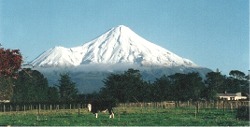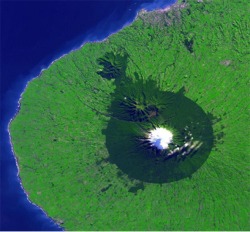Mount Egmont / Taranaki
Home > New Zealand Information > Mount Taranaki Information
Mount Taranaki
From Wikipedia, the free encyclopaedia
| Taranaki | |
|---|---|
 Taranaki |
|
| Elevation: | 2,518 m (8,261 ft) |
| Latitude: | 39º 18′ 0″ S |
| Longitude: | 174º 4′ 0″ E |
| Location: | New Zealand |
| Range: | none |
| Type: | Stratovolcano |
Mount Taranaki (also called Mount Egmont) is a dormant stratovolcano located in the west of New Zealand's North Island.
The 2518-metre-high mountain is one of the most perfectly-shaped volcanic ash cones in the world. There is a secondary cone, Fantham's Peak, on the south side. Because of its resemblance to Mt. Fuji, Taranaki provided the backdrop for the Tom Cruise movie "The Last Samurai".
Mount Taranaki is geologically young, having commenced activity approximately 135,000 years ago. The most recent volcanic activity was a moderate ash eruption which occurred about 1755. Mount Taranaki is considered unusual in that it has experienced at least five of its major eruptions by the method of cone collapse. Few volcanoes have undergone more than one cone collapse. There is also evidence of lahars being a common result of eruption.
Taranaki is a relatively easy mountain to climb and many do so each summer. It takes a reasonably fit person a day to make the up-and-back climb. However, weather on the mountain can change rapidly, catching inexperienced trampers unawares. A number of people have died on the mountain after being caught unprepared in bad weather.
View of Mount Taranaki from Stratford
(facing west). Fanthams Peak can be seen
to the left of the main peak. Note the cow
in the foreground; Taranaki is a major
dairying region of New Zealand.
The mountain is revered by Maori who tell a legend about its origins.
The Mountain's Name
For many centuries the mountain was called Taranaki by the Maori. Captain Cook called it Mount Egmont after the Earl of Egmont. This was later changed as it was considered inappropriate to have it renamed after a British noble who had never set foot in New Zealand. The Egmont name still sees limited usage and still applies to the national park which surrounds the peak. Ironically, the name "Mount Taranaki" is linguistically redundant, since the word tara means "mountain peak". "Naki" is thought to come from ngaki, meaning "shining"-a reference to the winter, snow-clad, nature of the upper slopes.
National Park
Satellite image of Mount Taranaki from the
NASA Earth Observatory showing the nearly
-circular Egmont National Park surrounding it.
New Plymouth is the grey area on the northern
coast.
In 1881, a circular area with a radius of six miles (9.6 km) from the summit was protected as a Forest Reserve. Areas encompassing the older volcanic remnants of Pouakai and Kaitake were later added to the reserve and in 1900 all this land was gazetted as Egmont National Park, the second national park in New Zealand. With intensively-farmed dairy pasture reaching right up to the mostly-circular park boundary, the change in vegetation is delineated remarkably in satellite images.
Recreation
The Stratford Mountain Club operates the Manganui skifield on the eastern slope. Equipment access to the skifield is by flying fox across the Manganui Gorge.
Access
There are three roads leading part-way up the mountain. The highest is to East Egmont plateau, with a viewing platform and parking facilities for the skifield. It lies at the transition between subalpine scrub and alpine herbfields.
There are park visitor centres at North Egmont and at Dawson Falls on the southeast side.
There is no road access on the western side. However, a road winds for 10 km though native bush over the saddle between Pouakai and Kaitake. Near the top of this road is the renowned Pukeiti Trust rhododendron garden.




